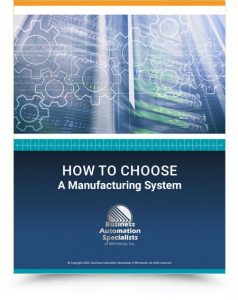
1. Determine Your Company’s Goals and Challenges
It is safe to say that current economic conditions are a significant challenge for businesses of any size. Smaller companies, however, do not cite it as their top challenge. Focused on creating a name for themselves, smaller manufacturing companies are most challenged with brand awareness and market exposure. While larger manufacturing companies struggle with the increase of competition within the market, employee retention and rising operating costs, the current economy remains their greatest challenge.
The overall goals and challenges of a business impact a company’s MRP strategy. Smaller companies tend to be more focused with the market and customer awareness while larger companies focus on costs and managing the growth of their organization. These concerns contribute to the development of the all-important MRP strategy. Small and medium-sized companies look to MRP systems to manage and drive their cost position, while preparing for future growth. Smaller companies also look to MRP systems to manage their operations; however, they place a higher priority on the customer experience.
2. Focus on Reducing Costs
While small and large manufacturing companies have different challenges that create distinctive MRP strategies, cost reduction is still the main driver of successful MRP strategies. As a result, manufacturing companies must focus their MRP strategies on business process execution. The strongest MRP strategies are developed by companies wishing to:
- Streamline and accelerate processes to improve efficiency and productivity
- Standardize business processes
- Provide visibility to business processes across functions and departments
- Optimize the use of current capacity
- Link global operations to improve interoperability and collaboration
3. Take an Integrated Approach
MRP is not a “one-size-fits-all” type of business management system. Every manufacturing company comes with its own unique sets of needs and standards, and a strong MRP strategy should meet the unique needs of each company. For that reason, many companies are turning to a multi-tiered MRP strategy in order to operate to their full capacity. In fact, recent research has shown that significant benefits can be gained from an integrated ERP solution.
Manufacturing companies who take an integrated approach to MRP are 3.4 times more likely to report a reduction in operational costs than companies who run a “one-size-fits-all” model. They are also 85% more likely to report a reduction in inventory costs and 2.6 times as likely to report an increase in profit.
Benefits of Developing Your Own MRP Strategy
The ongoing success of an MRP system and its contribution to the success of a manufacturing company is dependent upon the overall MRP strategy (not just the MRP implementation). Companies must take the time to set guidelines for how they define, monitor, support and apply their MRP system. Companies that maintain their MRP strategy and align that strategy with their overall business strategy, internal capabilities and business needs derive real operational benefits. Successful manufacturing companies monitor and measure not only their business operations, but they also monitor their MRP system and how it is performing and aligning with the business. With the proper strategy, MRP will bring greater visibility, lower manufacturing costs, reduced inventory and improved efficiency to any manufacturing company.
If you are currently considering making an MRP investment or would like to fully utilize your current MRP solution, developing an MRP strategy is key. Download our e-book, “How to Choose a Manufacturing System.”
If you are ready to take action and need practical advice on the next steps toward reducing costs, click here to sign up for a free 30-minute business consultation.
Do you currently use MRP software to manage your business? If so, do you have additional suggestions for ways to reduce manufacturing costs using MRP software?

